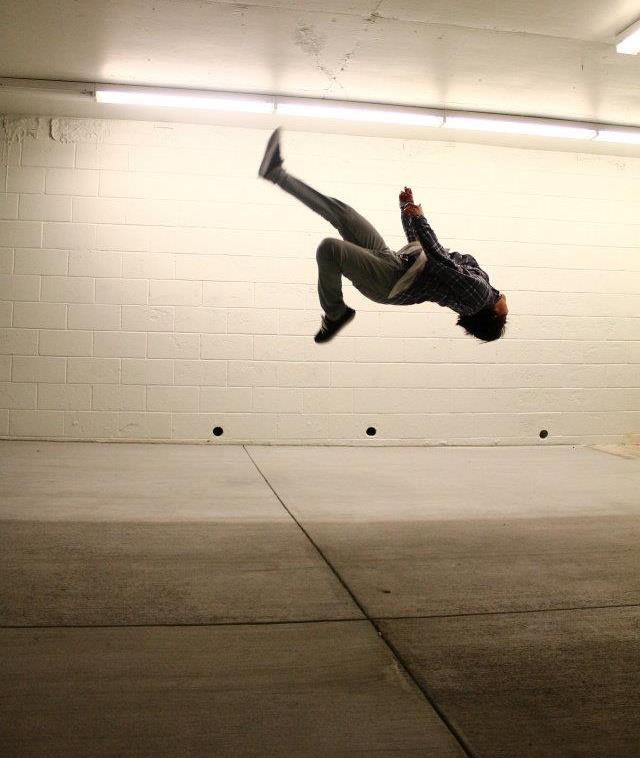|
Double Leg (trick)
{{Not to be confused with, Double leg takedown A Double Leg is a move that originated from Capoeira but was incorporated into Tricking (martial arts), tricking like many other martial arts moves because of its difficulty and aesthetics. Its Capoeira name is ''Armada Dupla'', which means a double armada. An Armada (Capoeira), Armada is the capoeira version of a Reverse Roundhouse kick. The distinguishing feature of this move is the fact that both legs remain together during the take off and execution; its name is derived from this feature. After the take off, the torso stays upright and vertical, but will begin to quickly torque in order to swing the legs around and upwards. At the peak of this move, the body is in the shape of a "V". The legs continue to swing over as the body straightens out for the landing. In tricking, this move can be done from a run, a step in, a standing position, or from another move in a combo. A standing position and linking it in or at the end of a combo a ... [...More Info...] [...Related Items...] OR: [Wikipedia] [Google] [Baidu] |
Capoeira
Capoeira () is an Afro-Brazilian martial art that combines elements of dance, acrobatics, music and spirituality. Born of the melting pot of enslaved Africans, Indigenous Brazilians and Portuguese influences at the beginning of the 16th century, capoeira is a constantly evolving art form. It is known for its acrobatic and complex maneuvers, often involving hands on the ground and inverted kicks. It emphasizes flowing movements rather than fixed stances; the '' ginga'', a rocking step, is usually the focal point of the technique. Although debated, the most widely accepted origin of the word ''capoeira'' comes from the Tupi words ''ka'a'' ("forest") ''paũ'' ("round"), referring to the areas of low vegetation in the Brazilian interior where fugitive slaves would hide. A practitioner of the art is called a capoeirista (). Though often said to be a martial art disguised as a dance, capoeira served not only as a form of self defence, but also as a way to maintain spirituality and cu ... [...More Info...] [...Related Items...] OR: [Wikipedia] [Google] [Baidu] |
Tricking (martial Arts)
Tricking is a training discipline that combines kicks with flips and twists from martial arts and gymnastics as well as many dance moves and styles from breakdancing. it is a martial arts that take its descent from Taekwondo, wushu and capoeira. It aims to achieve an aesthetic display of different combinations of "tricks". Tricking practitioners are commonly referred to as trickers. Examples of tricking techniques include the 540 kick, the corkscrew (cork), the flashkick, the butterfly twist and the double leg. History A tendency to exhibit techniques that are more flashy and complex was observed in martial arts during the period following the 1960s, predating the current tricking movement. Especially in taekwondo, an increasing emphasis on spectacular spinning, jumping or flying kicks developed during the mid-1960s with the introduction of international competitions. The actual sport of tricking is an internet phenomenon, emerging in the early 2000s. Xtreme Martial Arts ... [...More Info...] [...Related Items...] OR: [Wikipedia] [Google] [Baidu] |
Martial Arts
Martial arts are codified systems and traditions of combat practiced for a number of reasons such as self-defense; military and law enforcement applications; combat sport, competition; physical, mental, and spiritual development; entertainment; and the preservation of a nation's intangible cultural heritage. Etymology According to Paul Bowman, the term ''martial arts'' was popularized by mainstream popular culture during the 1960s to 1970s, notably by Hong Kong martial arts films (most famously those of Bruce Lee) during the so-called "chopsocky" wave of the early 1970s. According to John Clements, the term '':wikt:martial art, martial arts'' itself is derived from an older Latin (language), Latin term meaning "arts of Mars (mythology), Mars", the Roman mythology, Roman god of war, and was used to refer to the combat systems of Europe (European martial arts) as early as the 1550s. The term martial science, or martial sciences, was commonly used to refer to the fighting arts of E ... [...More Info...] [...Related Items...] OR: [Wikipedia] [Google] [Baidu] |


.jpg)